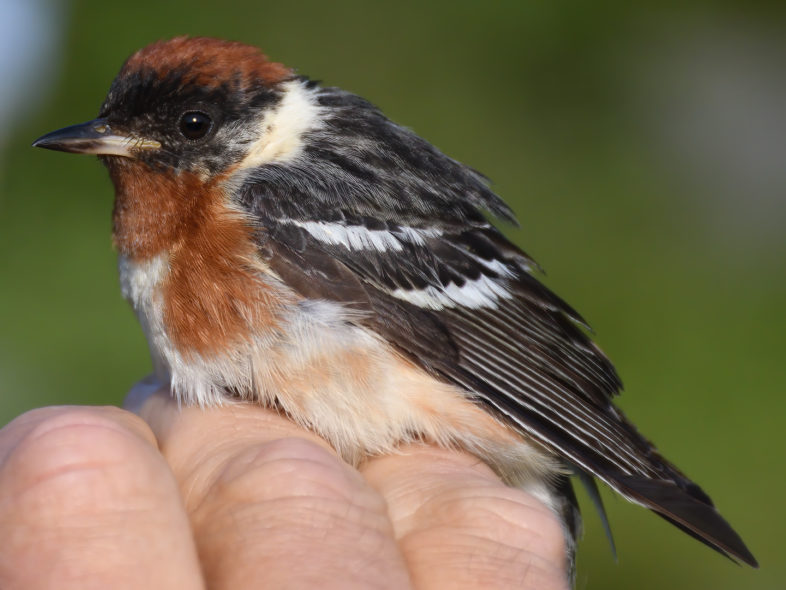
This yearling male Bay-breasted Warbler made an unexpected appearance in VCE’s mist nets on 15 July 2021. The bird, in early stages of primary molt, was likely either a non- or failed breeder and undergoing dispersal prior to southward migration. © Michael Sargent
VCE’s seventh weekly banding session on Mt. Mansfield found us deluged by baby juncos and exclaiming over our first-ever mid-summer Bay-breasted Warbler. After another stretch of wet weather caused a 24-hour postponement, our team snuck its weekly trip into the one forecasted dry slot on Wed-Thurs. With firs dripping from the day’s earlier rains, we set up nets in early evening, thankful that the radar map showed thunderstorms to be disintegrating around us. By nightfall, we had captured 15 birds, including the season’s second adult male Sharp-shinned Hawk and 3 Cedar Waxwings. Only one of us tempted fate and slept outside, while the rest of us cocooned in our vehicles.
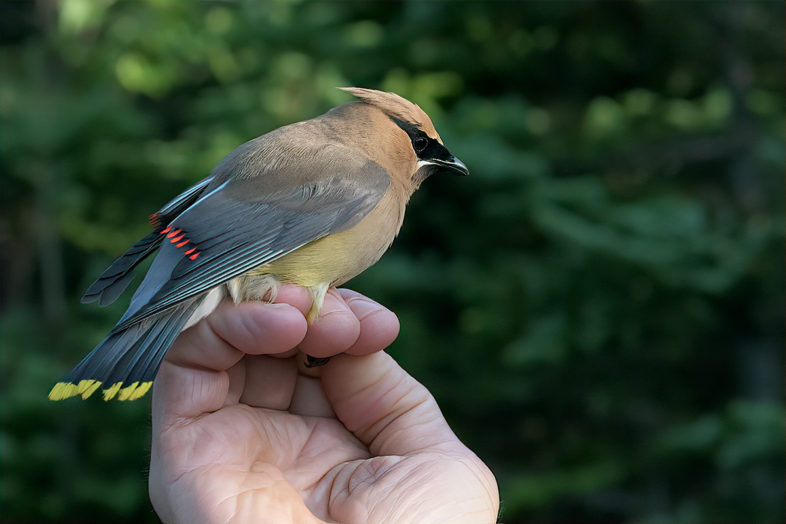
A sleek adult Cedar Waxwing, one of 3 that appeared in VCE’s Mansfield mist nets together on 14 July 2021. This low-elevation breeding species is not one that VCE captures annually on the ridgeline. © Charles Gangas
We reopened nets before first light and were treated to a vibrant sunrise, clouds clinging to the valleys below us. The dawn chorus was non-existent, but free-flying juvenile juncos compensated for the silence, crowding trail edges and filling our nets. By morning’s end, we had banded no fewer than 23. And yet, not a single juvenile White-throated Sparrow—a species every bit as abundant on the mountain—found its way into our nets. Whether juncos have had relatively higher nesting success this summer, juvenile white-throats are slower to gain independence from their parents, or some other factor accounts for this disparity in two species with similar nesting phenology, we don’t know. Suffice it say that juncos kept us busy.
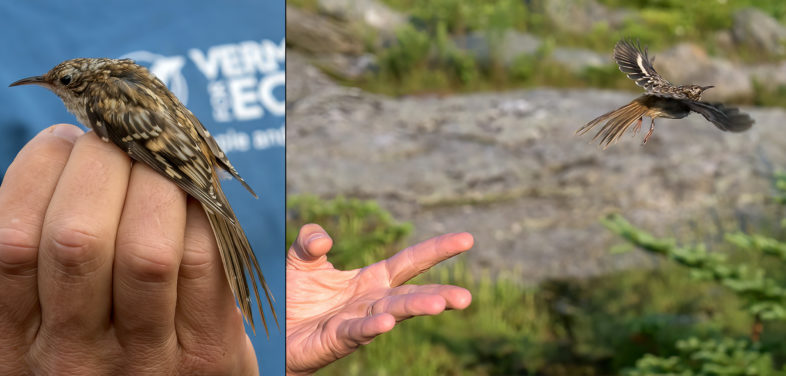
A juvenile Brown Creeper graced the VCE nets on Mansfield and made a quick getaway upon release, 15 July 2021. © Charles Gangas
As expected, independent non-local juveniles—Golden-crowned Kinglets, a Brown Creeper, a Hermit Thrush—added to the morning’s array of netted birds. Most unexpected was our capture of an early-molting Bay-breasted Warbler, a striking yearling male who had dropped his innermost two primaries. This was VCE’s first-ever July record of this spruce budworm specialist on Mansfield; the species is not currently known to breed in Vermont, where nesting has been confirmed only once, in 1980 during the first Vermont Breeding Bird Atlas. Our netted bird was likely either an unmated non-breeder or a failed early-season nester, who wandered south from Canada’s boreal forests. It may remain on Mansfield to complete its molt or continue dispersing, prior to migrating a month or so from now to northern South American wintering grounds. Needless to say, the bird was a rare treat for us banders.
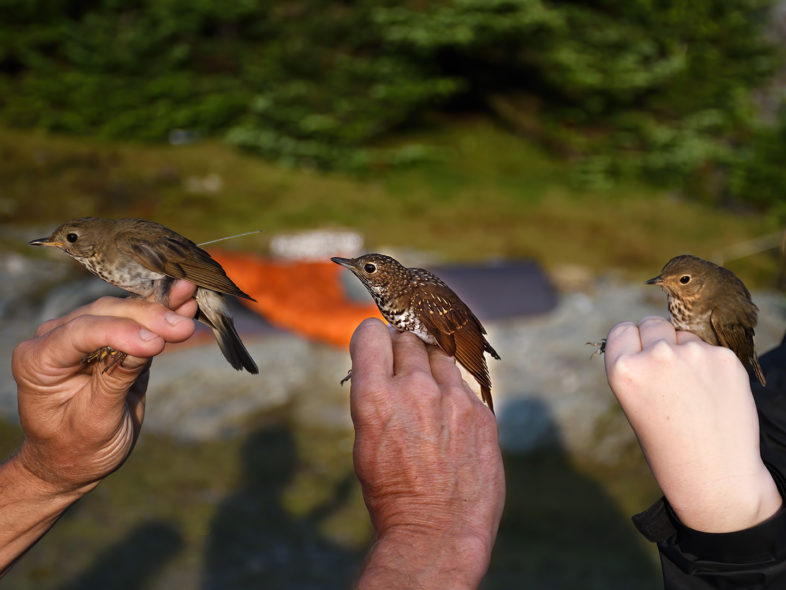
A trio of banded Catharus thrushes on Mansfield: from left, an adult Bicknell’s (with GPS tag antenna visible), a free-flying juvenile Hermit, and an adult Swainson’s. © Michael Sargent.
Our final tally of 57 captures included:
Sharp-shinned Hawk — 1 new 2+ year-old male
Golden-crowned Kinglet — 4 new free-flying juveniles
Brown Creeper — 1 new free-flying juvenile
Bicknell’s Thrush — 5 males (2 new, 3 within-season recaps)
Swainson’s Thrush — 1 new yearling male
Hermit Thrush — 1 free-flying juvenile
American Robin — 1 free-flying juvenile
Cedar Waxwing — 4 (3 adult males, 1 female)
Dark-eyed Junco (Slate-colored) — 25 new bandings (2 adult males, 23 free-flying juveniles)
White-throated Sparrow — 1 new adult female
Bay-breasted Warbler — 1 new yearling male in early primary molt
Blackpoll Warbler — 8 (1 new juvenile, 1 return male from 2020, 6 within-season recaptures)
Yellow-rumped Warbler (Myrtle) — 4 (3 new free-flying juveniles, 1 new adult female)
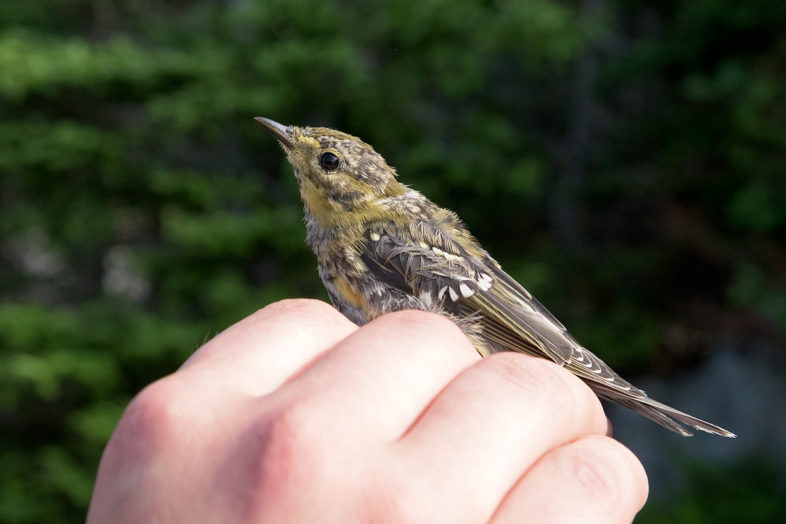
A juvenile Blackpoll Warbler in early stages of molt into its first basic (winter) plumage, 15 July 2021, Mt. Mansfield, VT. © Charles Gangas
As always, we had several eager, appreciative visitors, who relished the opportunity to learn about montane forest birds, see them up close and personal, and even experience some intimate encounters. It is hard to believe that only three field visits remain in VCE’s 2021 summer season…
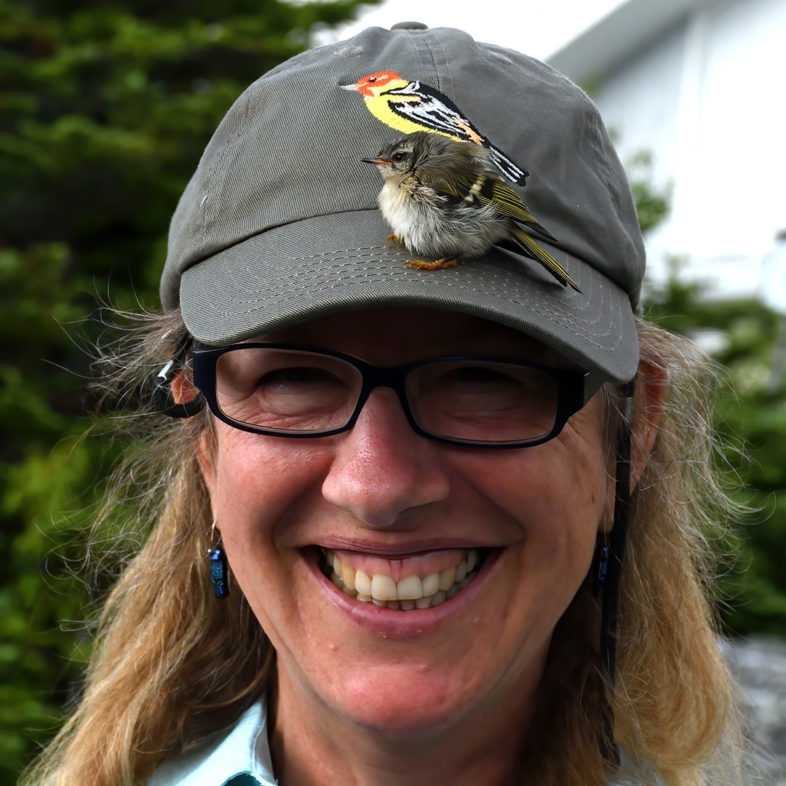
Rebecca Lovejoy with a banded juvenile Golden-crowned Kinglet that just didn’t want to leave (or was intrigued by the Western Tanager on her hat). Mt. Mansfield, 15 July 2021. © Michael Sargent

The photo of the various species of thrushes allows for a real teaching experience. Nice to be able to compare plumages.
Thanks Chris. I do love reading these reports and thinking back on the time when I was fortunate enough to be one of the Mt. Mansfield visitors. I hope you know how appreciative we are that you extend an invitation to the public. The photo of the Golden-crowned Kinglet on Rebecca’s cap is priceless!